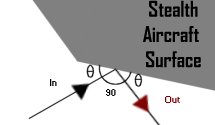The
Physics of Stealth
The Blackbird is considered as a
strategic reconnaissance aircraft, this is simply an fancy
name for a spy plane and to be one the aircraft must be able
to
mask its presence be it visual or through sound and against
technology such as radar.
photo from
http://www.globalsecurity.org/intell/systems/sr-71-pics.htm

The Sr-71 easily fulfills all the
requirements needed in order for it to be concealed from the
enemies as shown by its stellar record during its deployment
in the field. In terms of speed, the Blackbird reached
maximum velocities of
Mach 3.3 or about 2,200 mph. It also cruised at about
80,000 ft above ground so there is typically no way of
seeing the aircraft with just the naked eye. The most
important however is its ability to hide from radar.
Radar Stealth:
In order to understand how to hide from it, one must know
how radars work in the first place. A radar is a tool which
is used to find the location of an object in a certain
area. This is done by using the fact that radio signals
bounce off of metal surface which is a major component in
most aircrafts. To make an aircraft more aerodynamic,
engineer create them with a specific shape that reflects
radio signals in all direction. This of course includes the
direction back to the radar which then pinpoints the
location of the aircraft. With this in mind, the designers
of stealth aircrafts created a more flat shape for their
planes in order to reflect radio signals in other directions
thanthe radar thus inducing a sort of invisibility.
Lastly, aside from being able to hide from radar an aircraft
must also be able to hide its heat signature. This can be
problematic as going as fast as the SR-71 can produce lots
of heat due to friction. The next page
will explain how the Blackbird manages to keep itself from
overheating even when speeding at Mach 3.3.


photo from http://ffden-2.phys.uaf.edu/212_fall2009.web/michael_lowe/physics.html